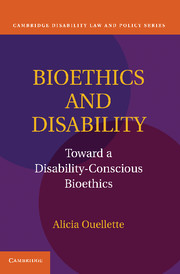4 - Childhood
Published online by Cambridge University Press: 07 June 2011
Summary
The experience of children with disability in the clinical setting is as varied as any other human experience. Many children with disabilities lead rich, full lives in which they attend school, play with friends, participate on sports teams, and come into contact with physicians for little other than routine well-child care visits. Other children with disabilities, particularly developmental disabilities, may be physically healthy but limited in their capacity for mental and social development. Still others may face disability-related or other health problems that bring them into regular contact with the health care system. Like all parents, parents of children with disabilities are the primary decision makers for their children. They make decisions about whether, when, and how to treat illness or use technology to correct or improve functionality. They also make decisions about whether, when, and how to manage the particular physical manifestations or social needs resulting from disability. As with most medical decision making for children, the process by which parents make medical decisions for children with disabilities is mostly unremarkable. The parents consult with the child's doctor, weigh the risk and benefits of medically reasonable alternatives, and then make the decision that is, in their estimation, in the best interest of their child.
The deference given parental decisions in the health care setting is more than a matter of convenience or custom. A parent's right to make medical decisions for his or her child is protected by the Due Process Clause of the Fourteenth Amendment.
- Type
- Chapter
- Information
- Bioethics and DisabilityToward a Disability-Conscious Bioethics, pp. 137 - 193Publisher: Cambridge University PressPrint publication year: 2011

